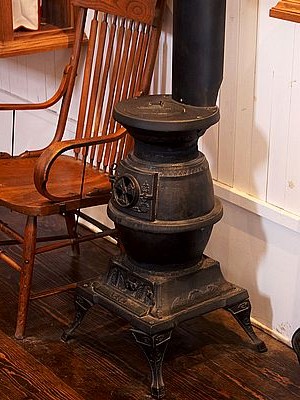Whatever Happened to Pot-Belly Stoves?
 Years before today’s high-efficiency, modern-looking, and large fire-viewing wood stoves, people heated their homes with various forms of wood burners. The landscape for free-standing wood stoves was much broader than it is today – anyone could build and sell a stove to people willing to pay for them – and none was more iconic and useful than the ‘pot-belly’ stove. Resembling a fat man’s pot-belly, the stove was squat, most times cast-iron, and featured a bulging, rounded fire loading area in the front. These stoves were built throughout the 1900’s and most times could either burn wood or coal, or a combination of the two.
Years before today’s high-efficiency, modern-looking, and large fire-viewing wood stoves, people heated their homes with various forms of wood burners. The landscape for free-standing wood stoves was much broader than it is today – anyone could build and sell a stove to people willing to pay for them – and none was more iconic and useful than the ‘pot-belly’ stove. Resembling a fat man’s pot-belly, the stove was squat, most times cast-iron, and featured a bulging, rounded fire loading area in the front. These stoves were built throughout the 1900’s and most times could either burn wood or coal, or a combination of the two.
Becoming an icon of the 20th century has led to antique collectors and nostalgic fireplace visions of pot-belly stoves dancing in people’s heads. It’s hard to ask people what they imagine when people think of wood-stoves without the pot-belly at the top of the list. The stoves frequently pop up in photographs and on popular design websites such as Houzz, Pinterest, and Porch. Even though the stove is much past its prime, the aura lives on much like a famous sports star, defining the generations it lived through.
So, what happened to pot-belly stoves? Why have they all disappeared from stores and people’s houses?
In short: the EPA. The Environmental Protection Agency (EPA) regulates the wood-burning industry to make sure all new fireplaces, stoves, and inserts fall below a certain pollution level. By doing this, manufacturers have designed ways to not only burn the wood but also burn the wasted smoke – in ways called ‘secondary combustion’ necessary to meet these strict guidelines. Every set number of years the grams-per-hour number lessens and becomes more difficult to meet. When this happened, many of the small-time stove builders simply couldn’t meet the standards, and were forced to either go out of business or build stoves that could. Different combustion chambers were necessary and other things never needed before – baffle boards, catalytic combustors, etc., were now built into different stove designs capable of housing them. The pot-belly stove wasn’t clean enough.
In addition to the EPA standards, new building codes and insurance restrictions over the years made it increasingly difficult to install a pre-EPA wood stove of any kind. Due to liability reasons, old stoves are often subject to incredibly large clearance distances and some insurance companies won’t allow them at all – which has made the stoves more of an antique than anything else. DIY installers have gotten around certain restrictions, but for most people looking for a safe & decorative heat source, pot-belly stoves just aren’t viable anymore.
 Changing tastes in style has also led to a more modern and sleek marketplace, even from true classic stove brands such as Jotul, Hearthstone, and Vermont Castings. Clean-faced models with large glass doors offer customers beautiful views of their fires, where before only cast-iron doors stood in the way. This demand has led manufacturers to invest in R&D to pursue current tastes in favor of re-inventing old stoves to make them EPA-approved for production.
Changing tastes in style has also led to a more modern and sleek marketplace, even from true classic stove brands such as Jotul, Hearthstone, and Vermont Castings. Clean-faced models with large glass doors offer customers beautiful views of their fires, where before only cast-iron doors stood in the way. This demand has led manufacturers to invest in R&D to pursue current tastes in favor of re-inventing old stoves to make them EPA-approved for production.
Add up all the variables and you get a complicated answer. Ultimately, pot-belly stoves have earned their right among the classic products of the 1900’s but the world we live in today is far different and more restrictive. If you stumble upon one of these stoves at an antique store or an estate sale, consider some of this before picking it up, but it might be worth snagging just to say you were in on the action.
